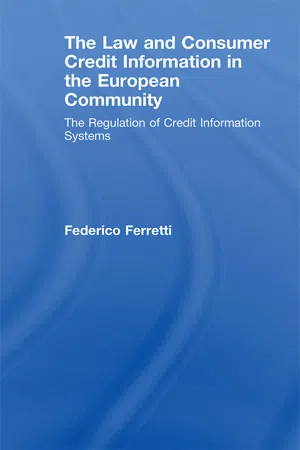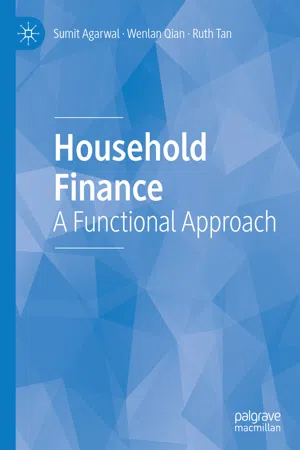Credit Rationing
Credit rationing refers to the situation where borrowers are unable to obtain the full amount of credit they desire at the prevailing interest rate. This can occur when lenders impose restrictions on the amount of credit extended, often due to concerns about borrower risk. As a result, credit rationing can lead to inefficiencies in the allocation of credit in the economy.
5 Key excerpts on "Credit Rationing"
- eBook - ePub
The Law and Consumer Credit Information in the European Community
The Regulation of Credit Information Systems
- Federico Ferretti(Author)
- 2008(Publication Date)
- Routledge-Cavendish(Publisher)
...the economic literature Economic theory has long stressed the importance of information in credit markets. The exchange of financial data and customers’ information sharing devices has been the subject of a large body of academic literature in economics. Theorists have long aimed to show that access to credit is essential for economic development and growth. To this purpose, the subject relating to the effects of asymmetric information and Credit Rationing in credit markets has been thoroughly analysed. The economic model pioneered by Akelof in 1970, who takes the used car market as an example, is often cited as the first economic study to recognise the issue of quality uncertainty, the importance of trust, and the role of asymmetric information in financial relationships. 3 Jaffee and Russell followed in 1976 by prospecting in economic terms that there is a link between the issue of asymmetric information and the problem of Credit Rationing. 4 However, the first generation of theoretical treatment of asymmetric information in credit markets was developed in 1981 by Stiglitz and Weiss, who used the small business credit market as the economic model to understand why is credit rationed. 5 Their paper is today considered as incontrovertibly one of the most influential papers on adverse selection in credit markets and the economic basis for the existence and explanation of credit reporting. The findings of the study are best summarised by the authors’ own words: … Banks making loans are concerned about the interest rate they receive on the loan, and the riskiness of the loan. However, the interest rate a bank charges may itself affect the riskiness of the pool of loans by either: 1) sorting potential borrowers (the adverse selection effect); or 2) affecting the actions of borrowers (the incentive effect)...
- eBook - ePub
- Henry S. Hazlitt(Author)
- 2016(Publication Date)
- Golden Springs Publishing(Publisher)
...22—Must We Ration Credit? The proposal to restore “selective” or “qualitative” credit controls is revived so often by persons who are regarded as monetary authorities, and is so frequently referred to by them as “one of the necessary weapons to combat inflation,” that some further analysis is desirable. The proposal has the sanction of precedent, for whatever that is worth. Our government used “selective” credit controls at various times between 1941 and 1952. They have been widely imposed in Europe. But the results hardly warrant emulation. Selective credit control is merely one more step along the road toward a command economy. It leads logically back to investment control and to price control. Selective credit controls are, in fact, government control of short-term investments. The pressure for them comes from special groups of borrowers who want to be favored at the expense of the rest. It comes from monetary managers who lack the courage to refuse such demands; who lack the courage to let general interest rates rise to the point where they will halt inflation. When the price of any commodity is held down by government control, the demand soon exceeds the supply, and the commodity is then rationed. Selective credit controls are merely government rationing of credit. To ration credit is, of course, to discriminate among would-be borrowers. The decision is thrown into politics and determined by political pressures. This has already happened. Buying a house, even if you can’t afford it, is considered so laudable that the taxpayers have been forced to guarantee 95 per cent of the purchase price for you. Buying a refrigerator to put into the house, or a car to get to work from it, is considered much less laudable, so that the terms on which the seller was allowed to extend credit even at his own risk were tightened or “liberalized” by bureaucratic decree...
- eBook - ePub
- Gerard Roland(Author)
- 2016(Publication Date)
- Routledge(Publisher)
...Second, we would say that a firm is credit constrained if the borrower wanted to borrow more than all possible lenders were willing to lend at a given interest r. In order to make those two definitions operational, assume that there are only two lenders, a bank and the “market.” The former lends at rate r b and the latter at rate r m, where r b < r m. This assumption reflects the fact that under the priority lending program, firms obtained loans at an interest rate that was lower than the market rate. Figure 15.1 illustrates the case of a firm that is credit rationed but not credit constrained. The horizontal axis represents k, the amount of capital invested. The vertical axis measures the marginal product of capital F ′(k). The marginal product of capital is decreasing and therefore downward sloping: as the firm increases the size of its investment, the last unit of capital adds less to output than the previous unit of capital. Assume that, initially, at interest rate r b, the supply of capital to the firm is limited to k b 0 and that at interest r m, the firm can borrow as much as it wants. The firm is thus credit rationed with the bank, but is not credit constrained because it can borrow as much as it wants on the market. Under those conditions, the firm’s total demand for credit is k 0. Indeed, k 0 is the level of capital at which the marginal product of capital is equal to the market interest rate r m. For a level of capital above k 0, the marginal product is lower than the interest rate, which means that the firm would lose money from investing above k 0. The firm would thus borrow k b 0 at the lower rate r b and the difference between k 0 and k b 0 at rate r m. FIGURE 15.1 A Credit-Rationed Firm A firm can borrow k bo from the bank at rate r b and the difference up to k 0 at rate r m. At k 0, the firm’s total demand for credit is satisfied as the marginal product of capital is equal to r m. The firm is credit rationed but not credit constrained...
- eBook - ePub
The Capital Budgeting Decision
Economic Analysis of Investment Projects
- Harold Bierman, Jr., Seymour Smidt(Authors)
- 2012(Publication Date)
- Routledge(Publisher)
...To distinguish between them, we shall refer to the former situation as internal capital rationing and to the latter as external capital rationing. External capital rationing is actually the result of market imperfections or transaction costs or perceptions of imperfections. Two observations should be noted. First, capital rationing in both the first and second form is present throughout the economy, but usually to a relatively minor degree, and thus may frequently not be incorporated into the analysis (although it should not be ignored without trying to estimate its impact). Second, when capital rationing is present, there is no simple solution to the firm’s investment decision. Two possible approaches are offered. The first possibility is to make simplifying assumptions where appropriate and to recognize that the answer obtained is an approximation. The second approach is to use mathematical techniques to develop possible solutions, following different possible investment alternatives (including all possible combinations of investments through the succeeding years). This analytical technique may lead to a sound solution to the capital-budgeting decision under capital rationing, but it is complex and requires detailed knowledge of future investment alternatives that is frequently not available. External Capital Rationing In this chapter the term borrow is used when a firm obtains capital from the market by issuing any type of security. The term lend is used to mean the use of funds to purchase any type of security. We specifically assume that borrowing takes place in such a way that the borrowing firm’s capital structure (the relative proportion of the various kinds of securities it has issued) is not changed. Thus, borrowing would normally involve issuing both debt and equity securities. Similarly, we assume that lending means acquiring a portfolio of securities that has approximately the same average risk characteristics as the assets presently owned by the firm...
- eBook - ePub
Household Finance
A Functional Approach
- Sumit Agarwal, Wenlan Qian, Ruth Tan(Authors)
- 2020(Publication Date)
- Palgrave Macmillan(Publisher)
...The gap suggests that there are borrowers whose needs are not fully met so they either underpay or overpay. Zinman (2014) postulates that this could be due to regulations restricting high-cost consumer loans (Carrell and Zinman 2014) or to asymmetric information including problems in screening borrowers (Einav et al. 2013). The asymmetric information typically considers one of three situations. First, “hidden information” such as repayment likelihood of borrowers or profitability of lenders can lead to adverse selection on project risks and borrower types (Dobbie and Skiba 2013). Second, “hidden actions” such as reduced repayment effort of the borrower after the disbursement of the loans are hard to predict. Third, hidden information and hidden action interact, for example, missing information in the contract induce borrowers to commit moral hazard leading to Credit Rationing and an undersupply of credit (Zinman 2014). Theories in support of the view that there is credit oversupply include (1) advantageous selection, (2) fire sales of collateral, (3) a slow recovery from shock, (4) cash-out refinancing of mortgage and (5) behavioral consumers who borrow excessively. Advantageous selection in the credit market can happen when less risky borrowers borrow at unfavorable terms and choose a credit supply beyond what they require (De Meza and Webb 2000). Fire sales of collateral can happen in the event of a bad shock. Lenders become concerned about collateral values and force borrowers to repay their loan by selling the collateral. The mass selling of collaterals can cause the value of other collaterals to fall giving rise to the perception that there is too much debt (Mian and Sufi 2015). An area entering a downturn with high leverage will face a higher drop in demand for credit...




